by Todd Walker
Disclosure (5/11/2016): In all honesty, after almost two years since making this tarp, it has held up fine until this spring. It’s still in tact and waterproof. However, it must be the Georgia humidity that has caused the tarp to turn sticky. Just wanted to make this disclaimer for anyone in humid climates. Your results may vary.
Weight – a unit of heaviness or mass; any heavy load, mass, or object; the vertical force experienced by a mass as a result of gravitation
Gravity. It’s unescapable… on this planet. It keeps us grounded. But it also weighs us down.
I consider myself to be in decent physical condition. Even so, at my age, every pound added to my backpack affects the gravitational pull and energy needed to carry the stuff. I’m no ultralight hiker by any stretch, but I do try to lighten my load every chance I get.
I’ve wanted to own an oilskin tarp for some time now. They’re durable but too pricey for our budget at this time. A quality oilskin tarp (new) will set you back $200. My motto, when it comes to gear, is buy the best you can afford. Or, go the common man route and make your own.
The idea for this project came from William Collins’ 4 part series on his YouTube channel. I’ve condensed his method into a short tutorial for you.
Stuff You’ll Need
- 100% Egyptian cotton bed sheet (flat). The higher the tread count the better. I used a king size which measures 8.5′ x 9′.
- 20 oil lamp wicks (1/2″ x 6″). They come in packs of 5 at Wally World.
- Boiled linseed oil – 3 to 4 cups (depending on the size of your cloth)
- Mineral spirits – 3 to 4 cups
- Dye (optional) unless your sheet is the color you desire
- Containers
- Heat source
- Rubber gloves
Prep the sheet: Before the dyeing process begins, wash the sheet in cold water and washing powder. Then dry on high heat to close and tighten the woven fibers in the sheet.
Sew the lamp wicks on all corners and at two foot intervals along the edges. I sewed these on by hand. A sewing machine would take less time but that’s how I roll. I added 3 additional loops down the center of the sheet to allow for more options when configuring my tarp.
Step 1: Making Natural Dye
I filled the bottom of a 10 inch pot with green hickory nuts from a tree in our yard. Thank you, squirrels! Use an old pot that you don’t mind staining. I then added several black walnuts (green hulled) to the mix which happen to be dropping from trees now.
With the dyeing agent (green nuts) in the pot, fill 3/4 full with water. Bring to a boil on an outdoor fire. Allow to slow boil for an hour or more. The longer you boil, the darker your dye will become. I was going for an earth tone.
You can also break the green hulls off the black walnuts to increase the surface area and improve the extraction process. Be aware that the hulls will stain anything they touch – skin included.
If you choose not to make your own natural dye, RIT dye is available at most grocery stores.
Step 2: Dye the Sheet
Test the color of your dye on a piece of scrap cloth. If you’re satisfied, strain the dye mixture into a clean container. A window screen over a bucket works well.
Place the sheet into the container. Use rubber gloves to prevent staining your hands. Turn and squeeze the material for a thorough coverage.
Leave the sheet in the dye for 24 hours. Longer for a darker color. To keep the sheet submerged, I place the lid of cast iron dutch oven on top. Not recommended. The greasy drip spikes on the lid left a polka dot stain pattern on the bed sheet. What was I thinking!? I replaced the heavy lid with one of DRG’s small dinner plates and a 25 lb. dumbbell.
Step 3: Set the Dye
Wring the sheet over the container to remove the excess dye. I hung mine over a double clothes line out back to dry.
Once dry, wash it in cold water with washing powder when your wife isn’t home. No, it won’t stain the washing machine tub. The cold water sets the dye. Dry the sheet on high in preparation for the waterproofing.
Step 4: Waterproofing
Mix equal parts boiled linseed oil and mineral spirits (drying agent) in a container. I used a 5 gallon bucket. You only need enough to completely saturate the cloth. I used two cups of each and found dry spots on the sheet. Another cup of each did the trick. Other DiY’ers have “painted” the oil on their cloth. For the best coverage, message the oil into the material in a bucket. You’ll probably want gloves for this step.
Squeeze the excess mixture from the sheet back into the bucket. Funnel the extra waterproofing liquid in a smaller container and label it for later projects. I used the empty mineral spirits can.
Note on boiled linseed oil: Properly dispose of any oil soaked rags used to wipe spills. As the linseed oil dries, it creates heat and can combust spontaneously.
Worried about burning down your shop or barn while the tarp hangs to dry? Don’t be. Spreading the tarp to dry dissipates the heat.
Step 5: Cure the Sheet
Hang the oiled sheet vertically under a covered roof outside. In a hurry, I laid my sheet over the double clothes line. This method created two lines down the middle section of the sheet. Plus, it rained that evening. Dumb move. The next morning, water was standing on the sheet between the two lines. I hung the sheet under my attached shed behind my shop the next day.
The drying time on the oiled sheet depends on humidity. Well, it rained for three days after I applied the oil. You guessed it, the tarp stayed tacky. When the weather cleared, it dried in 48 hours.
Now for the moment of truth… is it waterproof?
I hung the dried tarp on the clothes line and unreeled the garden hose. I set the nozzle on “shower” and pulled the trigger. This was my common rain shower test. It passed! No moisture behind the tarp when wiped with a paper towel.
Now for the hurricane test. I set the hose to “jet” from three feet away and blasted the tarp. The paper towel underneath remained bone dry!
Even with standing water between the clothes line, no drips or moisture anywhere. Good to know the tarp could be used to harvest water in a survival scenario!
As far as durability, I’m pretty sure my bed sheet tarp won’t outlast an eight ounce canvas oilskin tarps. Maybe it will. Time will tell. I’m testing it this weekend at the Pathfinder School Basic Class. I’ll update y’all on its performance.
Keep Doing the Stuff of Self-Reliance,
Todd
P.S. – You can also keep up with the Stuff we’re Doing on Twitter, Pinterest, Google +, and our Facebook page… and over at the Doing the Stuff Network on Pinterest, Google +, and Facebook.
P.P.S – If you find value in our blog, Dirt Road Girl and I would appreciate your vote on Top Prepper Sites! You can vote daily by clicking here or on the image below. Check out all the other value-adding sites while you’re there…
Thanks for Sharing the Stuff!
Copyright: Content on this site (unless the work of a third-party) may be shared freely in digital form, in part or whole, for non-commercial use with a link back to this site crediting the author. All links in articles must remain intact as originally posted in order to be republished. If you are interested a third-party article, please contact the author directly for republishing information.

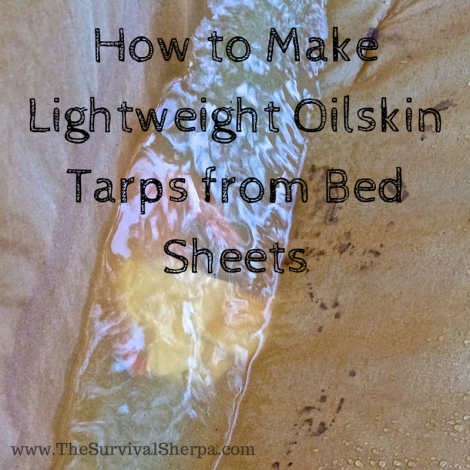
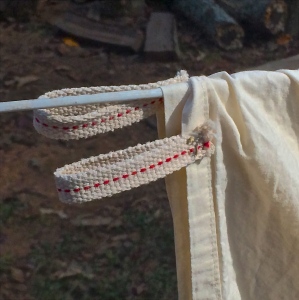
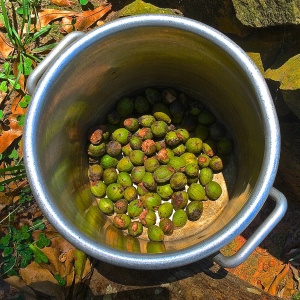
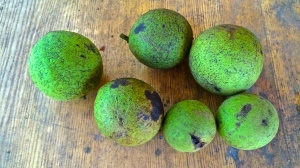
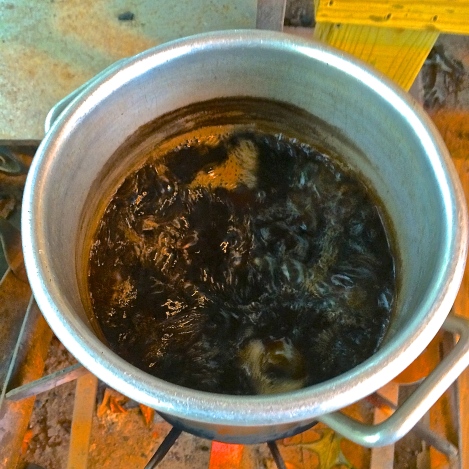
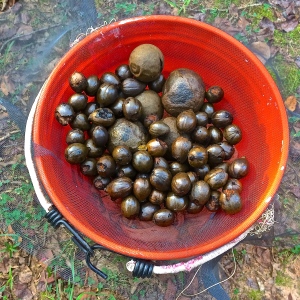
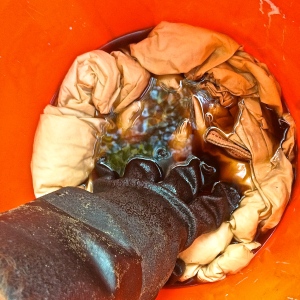
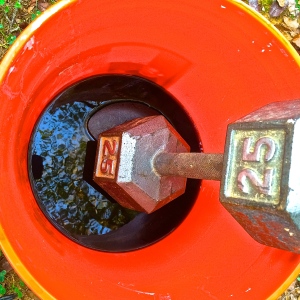
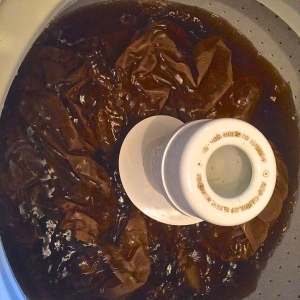





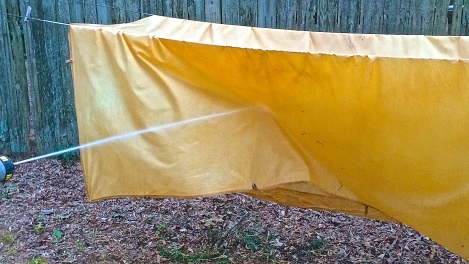
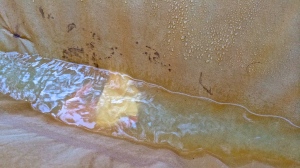








When I was a kid my grandparents shared all their knowledge with my cousin and me. Sometimes they just needed extra hands but we always came away with new knowledge. They always made sure to tell our parents how much they appreciated us helping and years later I realized all the survival skills I could utilize if I had too.
LikeLike
Pingback: How to Make Lightweight Oilskin Tarps from Bed Sheets | Modern Homesteader
This sounds great. I’m thinking to use it to make rain ponchos..more durable than the cheap ones in the store and lighter weight than the expensive ones.
LikeLike
Keep in mind that it’s not breathable. But with a poncho, it would work fine. Thanks for the comment, farmergranny!
LikeLike
hello, i was wondering if theres would be good to make a weekend tent that only used maybe for a week a year? want to use canvas in festivals as i cant stand the heat in nylon, and proper canvas is to heavy to carry the distance (along with the obscene amounts of booze people carry every year) im also getting older and need that comfort lol
LikeLike
Thanks for the article!
Hope you have a great time at basic class! I took my 17 year old back in March and it was a great experience for both of us. I picked up a bunch of easier ways to do things and it was good for us to spend the weekend together.
LikeLike
Glad you stopped in to take a look! Time with family is high in my ranking too. Looking forward to the skills training.
LikeLike
I just bought the Linseed oil and mineral spirits last night. I’ll be ready to try it as soon as I find a sheet my wife won’t miss.
LikeLiked by 1 person
The higher the thread count the better. Keep doing the stuff!
LikeLike
This sounds like a project I totally want to try for our homestead. I can think of about 100 places to use it.
LikeLike
Never have enough covering, brother! Let us know how it turns out for ya!!
LikeLike
Wow! I don’t know if I have the time to make it, but I sure do admire it!
LikeLike
I love this! I’m going to be trying this
LikeLike
It’ll take a week or so for the smell to disparate but we’ll worth the wait for DIY gear! Want to see it when you’re done!
LikeLike
I’m familiar with the smell of treated oil cloth, having camped in oil cloth tents in the 50’s. I wonder, could you introduce a scent (anything you find pleasant) to the linseed concoction to help with the oilcloth smell? Lavender, pine, etc?
LikeLike
I’m sure you could on the scent. I’ve never tried it. If you do, let us know how it worked for you.
LikeLike
Pingback: How to Make Lightweight Oilskin Tarps from Bed Sheets - Prepared Bloggers
Nice idea the only thing I will change when I make one is the sheet. I’ll use a painters tarp and update you on the results it should still be light weight but much thicker.
Thanks
LikeLike
Thanks for sharing. I will give this a go. 😊
LikeLike
Mine works like a charm, Tony! Let us know how yours turns out.
LikeLike
Pingback: 5 Lessons on Self-Reliance at The Pathfinder School | Survival Sherpa
Pingback: 5 Lessons on Self-Reliance - Patriot Rising
Pingback: How to Make Lightweight Oilskin Tarps from Bed Sheets | ATXPrep.com
Nice work-
I had the idea of using it on heavier denim/canvas material like Carhartt jeans for winter brush wear.. Winter mountain scrambling here requires very durable outer layers with water resistance.
Anyone else try something like this?
LikeLike
very good article. I read on a survival blog where some one added alum . whta twould this do for it???
LikeLike
Hey there! If I recall correctly, alum powder works as a fire retardant 🙂
LikeLike
my concern is about water collection would this be safe for drinking water
LikeLike
In an dire emergency situation, I’d drink water collected from this tarp. That would be my last choice of course.
LikeLike
Pingback: The Most Important Survival Tool - Survival at Home
Pingback: Luci Solar Lantern Review: A Lightweight Renewable Light Source | Survival Sherpa
Pingback: 5 Lessons on Self-Reliance at The Pathfinder School | Miles Johannesburg
Pingback: Is This Cotton Pickin’ Killer in Your Winter B.O.B.? | Survival Sherpa
Pingback: Top 31 Uses for “Killer” Cotton in Core Temperature Control | Survival Sherpa
Pingback: Luci Solar Lantern Review: A Lightweight Renewable Light Source | Miles Johannesburg
Thanks for this article. I have made 2 weatherproof waxed cotton parkas using a similar method, but with bees wax melted into the linseed first. Works a treat. I got both coats for £20 in a thrift store. They keep the rain out for hours, and are better looking and much tougher than any modern plastic waterproof.
I didn’t know that linseed oil on its own would work so well. I guess I will have to try this out in the new year, making a tarp tent.
LikeLike
Thanks for reading and the comment, Andy! There are many recipes out there for waterproofing. Be sure to let us know how your tarp turns out.
Would love to see a pic of your parkas!
LikeLike
Hi, thanks for the how-to. Can you tell me what the ending weight is?
LikeLike
Weighs in around 3 lbs when treated, Laurie.
LikeLike
Just came across your site. Great stuff sir. Pearls; tons of pearls.
Hope you’ll let me pick your brain a bit. Have seen a few of these on YouTube. Everyone always uses Egyptian Cotton. I get that thread count matters, but isn’t cotton cotton? Because that stuffs EXPENSIVE 😉
I’ve also noticed different weaves on the sheets; does that make a difference?
How does it shed the wind? Any get through?
Finally has it held up under use? What did the final weight come in at?
Thanks so much.
Christopher
LikeLike
Glad you found us, Christopher! I’ve only tried Egyptian cotton so can’t speak to other sheets. Mine was 350 ct. It has a tighter weave than non-Egyptian cotton. It is more pricey than normal cotton sheets but I’ve read others that tried it with normal cotton sheets and it wasn’t as rainproof or durable.
Mine weighs just over 3 lbs. It’s not as durable as an oilskin tarp or waxed canvas but the material is obviously different. It is indeed great for what it was created to be… a waterproof, windproof, fireproof tarp. Your intended use would dictate whether you go with DIY sheet or a heavier duty commercial tarp.
The tighter the weave the better. I did rip a tie out when I tensioned the line too much doing a ground set up.
Hope this helps.
LikeLike
Certainly does. Thanks.
Its really great to be able to get first hand experience without hardly any work. Got to love those interwebz. 😉
Thanks so much.
LikeLike
You’re welcome, bud! Glad to have you hanging with us!
LikeLike
Pingback: Top 5 Bug-Out Bag Necessities » Survival at Home
Pingback: Basic Prepper Training: Introduction to Survival
Thanks for the great information. I will be trying this soon. Just found your site and am enjoying the content!
LikeLike
Good deal, Russ! Glad to hear it’s helpful! We need an after-report… please.
LikeLike
Hi! I am planning on building a yurt for myself to live in this year. After reading your article (and also having an australian oilskin coat that is still waterproof after years of usage), I am wondering if it would be feasible to make the entire outer tarp from self-made oilskin. The two main questions are:
1) Would it stay waterproof for the entire wet season? (I can refresh the waterproofing every summer, I imagine.)
2) Would it start to molder if it doesn’t dry completely for several weeks?
What do you think?
LikeLike
Carlos, I wouldn’t be able advise you on your question. My tarp has held up fine for the limited use it’s seen. Year round exposure might pose a problem, not sure. I’ve never attempted it. Sorry.
Wish I could help you. Let us know what you come up with please. Sounds like a fantastic adventure!
LikeLike
Thank you for answering anyway! I am going to ask a few people with experience in building yurts or other constantly exposed tents, maybe some of them have tried linseed oil already. And I will definitely keep you updated if pursue this further.
LikeLiked by 1 person
Pingback: 49 Outdoor Skills and Projects to Try When Camping | Survival Sherpa
Hey Todd,
Great DIY article! I have a few questions regarding this process. I was wondering if this process will work on a lightweight 100% cotton field coat, and also, do you believe it would work on an M-65 military field jacket with a 50/50 nylon cotton blend?
Do the waterproofing oils dry completely enough so the coat won’t leave stains on furniture fabric, car seats, etc?
I appreciate all your hard work!
regards,
Adam
LikeLike
Thanks Adam! While I’ve only applied the recipe to 100% cotton with a tight weave, the properties of the mix should work on other materials like canvas or duck cloth. I’ve seen a few who have done so on canvas painter’s tarps.
Once dry and the scent goes away, I personally would not worry about staining. Of course, my tarp doesn’t rub on car seats, etc. I’ve not noticed any staining on my ruck or any transfer to other equipment in the pack.
If you try it, please keep us posted on the outcome, bud.
LikeLike
Great info! Thanks.
LikeLike
Pingback: Vital Outdoor Skills | Michigan Standard
I was looking to buy some oilskin jackets (Drizabones) for my kids but being 6, 5 and 3, they are all growing like weeds and those jackets are pricey. Too pricey to grow out of yearly, even with hand me downs.
I was linked a pin today from a friend for a hooded jacket and I hit up google to find an oilskin recipe. I reckon making up a light jacket from sheet fabric and then treating it with oilskin will make a lightweight and cheap coat I can easily replace/mend if it’s torn or grown out of. Thank you for easy to follow instructions!
LikeLike
How did this go for you? Was there any strong odor associated with this process or with the finished coats? Also – how important is the mineral spirits in this process? Thinking about skipping it or finding a non-toxic solution.
LikeLike
Actually, what we buy in home stores as boiled linseed oil is not pure and pretty toxic actually. I would avoid using it on clothing. You may want to research waxed cloth for a coat.
LikeLike
I haven’t done it yet. Life has just been crazy busy so it’s on the back burner.
LikeLike
Pingback: Made by Hands: Make it or Buy it? | Survival Sherpa
Pingback: Bushcraft and Survival Gear on a Budget » Survival at Home
would this work with wool blankets ??? would like to try..
LikeLike
To waterproof the wool blanket? Never tried that but would think It’ll ruin the blanket and take the insulating value away.
LikeLike
Is it necessary to utilize mineral spirits in the making of this oilskin? I was thinking of making an oilskin coat, but I worry about the toxicity of mineral spirits. What is the role that the spirits play in the compound / mixture? Faster drying / thinning agent? Thanks!
LikeLike
What is the thread count used in this instructional?
LikeLike
350
LikeLike
Pingback: The Number One Skill of a Good Woodsman | Survival Sherpa
Pingback: How to Improvise and Use a Three Stick Roycroft Pack Frame | Survival Sherpa
Hello,
I just have a few questions, does the fabric shrink very much? Do you think a 1000 thread cotton cover be durable enough to create a small tent?
Thank you
LikeLike
You’ll want to wash in hot water and hot dry to shrink the fabric fibers before treating. 1000 thread count should create a very dense weave and should work, Ben.
LikeLike
Just a quick question: How heavy is it?
LikeLike
Just over 3lbs.
LikeLike
Any idea as to how this would work with something that has seams? I would love to use this concept to make a lightweight skin on frame kayak that could be packed in a backpack. You wouldn’t want to tackle whitewater with it, but a leisurely paddle down a peaceful river would be a nice change of pace/scenery as well as give your feet a little rest. Would you treat it before or after fitting to the frame?
LikeLike
Now that some time has gone by how often have you had to re-apply your waterproofing? How well has it stood up?
LikeLike
Haven’t had to add any extra waterproofing since the first application. The material being a thin bed sheet is obviously less robust than canvas. I’ve had a few tie outs come off. Reinforcement at those stress points would be recommended.
LikeLike
Great info, thanks! Do you know if this would be okay for a tablecloth inside? Obviously lots of wiping down expected. How flexible is the fabric after treating? I plan on using a quality sheet like you did.
Thanks 🙂
LikeLike
Thanks, Lisa. I wouldn’t recommend eating off BLO treated fabric.
LikeLike
Oh, okay 😦 I’ll keep looking for something. I showed my husband your site and he loves it. So much great info.
Thanks
LikeLike
Sweet! Keep doing the stuff!
LikeLike
Pingback: How Cherokees Used Trees of Southern Appalachia for Food, Medicine, and Craft | Survival Sherpa
Nice tip! What does your tarp weigh when its finished?
LikeLike
Just over 3#. Lightweight compared to canvas oilskin.
LikeLike
This has to be one of the best DIY Waterproof tarps! Awesome job. Do you think this will work with with any 100% cotton sheet with above 300 thread count?
LikeLike
As long as the tread count is high and tight you should be okay.
LikeLike
I’ve been trying to figure out how to make a waterproof tarp out of some mill cloth I have, it’s canvas style cotton cloth. This gives me great directions so now I can make my own! Thanks
LikeLike
One place to pick up some bed sheets (if you don’t want to spend the money on new ones… Although you can buy new in any color you want) is at your local thrift store. For a 3 dollar bill, you are set to go, without having to deal with the wrath of your wife, when she comes home from work to find her bed stripped clean, and you in the garage with a goofy grin on your face, and saying hey babe, you’ll never guess what I’m doing.
LikeLike
I’m considering making one of these. DIY verses paying at least $80 wins the debate. Just wondering how yours is holding up?
LikeLike
Going to try a new formula. The BLO/Mineral Spirit mix still gets tacky in our GA humidity. More research is needed down here.
LikeLike
pretty basic stuff..good article. Why use did you use wicks for loops when cotton webbing is so cheap? was it simply convenience?
LikeLike
Yep. That was it.
LikeLike
Thanks for the update. If you got 2 years out of it then that’s pretty good. Any ideas why it might be getting tacky now?
LikeLike
I really think it’s the humidity, Corey. It feels dry when the humidity is low. Anywho, it was indeed a great diy project, I just would like to experiment on a better formula next time.
LikeLike
Hi Great instructions! ! Can you tell me how its holding up and is it safe close go a camp fire ?
Thanks
LikeLike
Pingback: Repurpose a King Sheet into an Oilskin Tarp | The Homestead Survival
Great project! I appreciate your contribution to field and your blog is very well done.
I wouldn’t use it to collect rainwater though, not just because mineral spirits are toxic, but because heavy metals are added to boiled linseed to oil in the form of metal salts, to act as a drying agent, and they are toxic even in extremely low concentrations. (Which boiling would increase.)
Thanks again and keep up the great work!
LikeLike
Many thanks, Cache! You make a very good point about BLO. Since writing this post, I’ve learned that information and need to update the article. Thank you again for pointing that important tip out!
LikeLike
Could this material be used to make a skin on frame kayak you think?
LikeLike
It’s water proof that’s for sure. And that may be a great idea, Corey.
LikeLike
I just found that post by accident, I was looking for projects for preppers in search of inspiration, your blog didn’t disappoint!! 👍🏻
I have selected a black sheet with a 500 thread Count, I hope that the black colour will make it warmer even if just slightly?..
I have seen some other posts in which they used beeswax instead of mineral spirits and called it tin cloth instead of oilskin. What would be the main differences between both methods?
In any case I’ll try this project real soon and will let you know.
LikeLike
Sorry but I have no experience with making tin cloth. I’ve read about it years ago but not much help.
Please do let us know how thing turn out for you. Glad you found us.
LikeLiked by 1 person
Great article! Wonderful advice and best step by step instructions given. Keep up the work!
LikeLike
Sure appreciate the kind words and your support!
LikeLike
I really want to try this! Do you think this would be suitable for smoking meats, in a teepee style smoker?
LikeLike
Extent info,thanks.
LikeLike
I recently pulled my oilcloth out of storage and discovered it was sticky also. There are some experiments I want to try to see if this can be fixed, but in the meantime here are some things to think about.
1. Humidity shouldn’t be effecting the BLO once it has cured. So I suspect that the quality of BLO that we are using is not as good (or consistent) as what used to be available. This makes sense as the drying agents are toxic heavy metals that are regulated. Normal users (woodworkers) may have adjusted there techniques to avoid this issue without noticing. If this is the case, then the solution to the problem may be to add a small amount of Japan Drier to the mix.
2. I used the excess oil/solvent mix to make tin cloth by adding melted wax. The gear that was treated with this hasn’t shown signs of being sticky. However, this might also be due to smaller quantities being applied.
3. There might be a better way to get the same effect. One site that I saw while trying to troubleshoot oilcloth suggested using silicone caulking that was diluted out with mineral spirits. I didn’t do any further research on that technique, but it should be feasible. Mineral spirits is the preferred solvent for removing silicone caulking.
Anyways, I will let you know if I have any success with my experiments to fix the problem after the fact.
LikeLike
Thank you kindly for the report and feedback on your oilskin. A friend used caulk in the recipe and says this solved the sticky problem for him. Looking forward to hearing the results of your experimentation!
LikeLike
I had heard a similar solution. So one thing I wanted to check is if it would work retroactively. The other two tests are to try and remove the excess BLO with 1) solvent and 2) soap and vinegar.
LikeLike
Fabric store (dot com) sells pure linen at various weights including : IL095 Natural canvas at10.2 oz /yd2. Price is $10.82/yard
Fabric specifications:
Article : IL095
Content : 100% Linen
Type : BASIC
Thread size warp : 5.5
Thread size weft : 9.09
Thread count warp : 27
Thread count weft : 32
Color : NATURAL
Weight : 10.2 oz/yd2
Width : 59 inch
Pre-wash in hot water and dry to get all shrinkage done and over before cutting to size and treating with your formula.
LikeLike
Hi
Thanks for the very interesting info
I wonder if it can be used to cover my caravan…
And please
What exactly is the caulk mentioned to eliminate the stickiness.
How is it applied
LikeLike
The caravan is parked in the open.. I don’t have a roof over to protect from the elements.. I also live in very humid conditions in richardsbay South Africa
LikeLike
Do you think this bed sheet oilskin would work for a cowboy bedroll?
LikeLike
It probably would if you only need a thin one. I don’t think it would hold up long on the ground if use repeatedly. You could use heavier material if need be.
LikeLike
Pingback: Repurpose a King Sheet into an Oilskin Tarp – The Homestead Survival
This could as easily be done with cloth drop cloths. Catch them on sale at Harbor Freight, sew a couple together with a french seam (enclosing some loops if you like). The cloths are dyeable. Proceed exactly the same..wash in hot water, dry in a hot dryer, etc. I would put the linseed oil/mineral spirits mixture in a cheap garden sprayer and lay the tarp out on dry ground or concrete and spray it. Spray a coat, let it soak in, spray again, etc until it has been completely saturated. You can hang to dry but I would likely leave it flat. I have treated canvas tents with Thompson’s water seal (the one for canvas) in this manner and it works quite well. No need to treat the inside too. I will be making a tarp like this and using the linseed oil mixture. Thank you for sharing your knowledge!
LikeLike
There is a company called Heritage Natural Finishes. They make some all natural products that would work outstanding for this. I recently contacted them and got some of their Pure Linseed Oil that is non toxic as well as liquid wax and their product called BeesBlock oil. This is the type of stuff that one could feel good about not getting poisoned if you had to use your tarp for emergency water collection. Autumn whom owns the business, is a great lady. Very knowledgeable and a great help.
LikeLike
Hi Todd,
Nice write up. I’ve been looking for something lighter and cheaper myself that isn’t a synthetic. Did you ever end up weighing the final product?
Thanks,
William
LikeLike
Sorry. I see that you replied with slightly more than 3 lbs in previous comments.
LikeLiked by 1 person
Hi Mate,
Just tried this technique with a canvas. Let it dry for near on 72 hours and it worked perfectly.
I let it sit a little longer on the line before rolling it into a blanket roll, then, after about an hour it started smouldering. I had it under the veranda and it likely got some of the evening sun. I do live in Australia, so we probably have a bit more heat in our sun than in the higher latitudes.
Word of advice for anyone just to store it open, other than this it is a great how-to
LikeLike
Would this be good for coveralls/bibs?
LikeLike
I wouldn’t wear clothing made of boiled lin seed oil. Not something I’d want against my skin all day.
LikeLike
I love this! Thanks! Can’t wait to do it.
LikeLike
Thanks for sharing , cool to make thuis summer with the kids! ( and hang it above the swimming pool and use tye dye).Give the horses schade. And for use by camping!
LikeLiked by 1 person
Hi, Todd. I’m also in Georgia & my bed sheet cloth took forever to dry & stayed stickier for even longer. It seems to be fine now but tears easily. The only change in method from your instructions was that I used powdered paint & mixed it with linseed oil & mineral spirits before applying. Can’t believe this discussion is older than my dog, ha ha. Thank you, and take care.
LikeLike